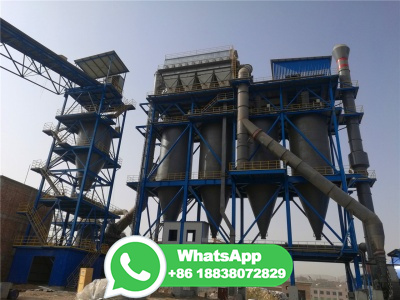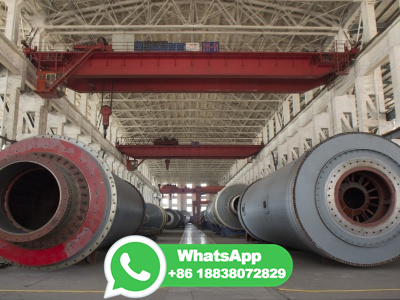
WEBThe feedstock for the plants is subbituminous coal supplied by Mining, a sister company of Synfuels. Natural gas is also used as a supplemental feedstock. A proprietary ironbased FT process is used to convert the synthesis gas (syngas) produced by the gasifiers to gasoline, light olefins (alkenes), and a variety of other products.
WhatsApp: +86 18203695377
WEBA steel plant produces steel using four different types of processes. The iron ore, coal, and labor required, the amounts of steel and side products produced, the cost information, and the physical limitations on the system are given below: Iron ore required Process type (tons/day) Side products Produced (tons/day) 5 1 2 8 3 3 4 10 Cost 50/ton Limitations .
WhatsApp: +86 18203695377
WEBNov 6, 1995 · The project has resulted in new methods for engineering design, new materials for hightemperature appliions, and new mechanical maintenance methods. More importantly, the innovative process provides potential routes for using synthesis gas to produce other chemicals from coal, further reducing dependency on foreign .
WhatsApp: +86 18203695377
WEBFeb 15, 2024 · Considering the insufficient strength and performances of formed coke products prepared using coke breeze with coal tar pitch and the excellent carbonization performances of biochar, this study proposes to enhance coal tar pitch carbonization by using biochar as its carbonization substrate for improving the product performances.
WhatsApp: +86 18203695377
WEBApr 1, 2019 · Compared with traditional process, several advantages by using methane and coal to coproduce methanol and power as two complementary raw materials can be concluded below: (1) Syngas for methanol synthesis is produced from two origins, involving in a low H/C ratio of syngas from coal gasifiion and a high H/C ratio of .
WhatsApp: +86 18203695377
WEBIndirect liquefaction is a twostep process. The first step involves gasifiion of coal to produce a mixture of hydrogen and carbon monoxide, called synthesis gas. In the second step, the synthesis gas is heated in the presence of a alyst to make hydrocarbons, with water being the major byproduct.
WhatsApp: +86 18203695377
WEBJun 12, 2023 · The total volume of products that refineries produce (output) is greater than the volume of crude oil that refineries process (input) because most of the products they make have a lower density than the crude oil they process. This increase in volume is called processing gain. The average processing gain at refineries was about % .
WhatsApp: +86 18203695377
WEBApr 1, 2019 · In China, coal reserves account for 70% of the primary energy structure. Hence it is a wise choice to use coal as the material to produce methanol [35]. The main process involves the coal gasifiion to synthesis gas, followed by highpressure alytic conversion of synthesis gas to methanol [8].
WhatsApp: +86 18203695377
WEBCoal is a key energy fuel in the production of aluminium a nonferrous metal known for its lightweight properties and widely used in cars, trains, and airplanes to reduce the weight of these vehicles and their energy consumption. Coal accounts for over 60% of the energy used to produce aluminium. Coalderived fuels, as well as coalbased ...
WhatsApp: +86 18203695377
WEBCOAL, PRODUCTION OFGEOLOGY OF COALCoal is a fossil fuel—an energy source whose beginnings can be traced to onceliving organic materials. It is a combustible mineral, formed from the remains of trees, ferns, and other plants that existed and died in the tropical forests 400 million to 1 billion years ago. Source for information on Coal, .
WhatsApp: +86 18203695377
WEBNov 24, 2020 · Coal tar is a hazardous and toxic waste, a byproduct of coal gasifiion processes. Coal tar is a waste produced in industrial fields such as steel, power plant, and the cement industry.
WhatsApp: +86 18203695377
WEBJun 3, 2022 · Both the quality and quantity of these products depends upon how the coal is heated, the gas atmosphere used during the process, and the temperature. The product distribution generated from these coal gasifiion technologies is presented in Table 1. As is still true today the coal gas in those early gasifiers was produced in several different ...
WhatsApp: +86 18203695377
WEBJul 1, 2004 · The coal dissolution process in the United States 22 is targeted to produce pitchlike products that can be used as a binder and a source in the manufacturing of highgrade coke for anode ...
WhatsApp: +86 18203695377
WEBCurrently, the best option for using coal to produce a high cetane number diesel fuel virtually free of aromatics and of S and N compounds is the FT process coupled with the applicable downstream workup of the crude FT product . Gasifiion of coal provides syngas, which is converted to a range of hydrocarbons.
WhatsApp: +86 18203695377
WEBMar 8, 2021 · However, the practical appliion of biomass has major restrictions [(Fick et al., 2013)] and there are still significant technical limitations to using biomass to completely replace fossil fuels in the BFBOF process: Price: At present, coke (coal after the coking process) is roughly 200/ton, compared with the cost of biocharcoal at 295 ...
WhatsApp: +86 18203695377
WEBJul 15, 2023 · Coking chemistry is the subject of relative theories, technologies, processes, and equipment of process where main material coal in the condition of isolating air is researched, and coal is transformed into coke (or semicoke) and raw gas after physicochemical action like thermolysis and coking, and the raw gas is purified and .
WhatsApp: +86 18203695377
WEBAug 1, 2004 · Our calculations show that in producing ferrosilicon using the electric arc process, ∼45 MJ/kg Mg ingot of electrical energy is consumed. This accounts for ∼97% of the electrical energy consumed by the product system. The global warming impact of generating the electricity required for the process from coal is kg CO 2 eq/kg Mg
WhatsApp: +86 18203695377
WEBJul 15, 2004 · The solvent loss in the process handling can be supplemented by a small amount of oil, which is produced from coal in the process, since the component of the coalderived oil is mainly tworing aromatics in the similar manner with the recycle solvent. Download : Download fullsize image; Fig. 1. Flow diagram of the Hypercoal process.
WhatsApp: +86 18203695377
Types of Coalderived Chemicals. The processes for production of specific chemicals from gasifiionderived syngas are typically proprietary systems using specialized process systems. In the following discussion, some of the processes for important chemicals such as formaldehyde, olefins, etc. are presented.
WhatsApp: +86 18203695377
WEBJun 10, 2020 · Methanol is an important feedstock of chemical engineering and energy source, and it is mainly produced by coal route in China. The coaltomethanol suffers from serious CO 2 emissions and carbon resource waste since water gas shift is involved in this process to increase hydrogen content of syngas for meeting methanol synthesis. A .
WhatsApp: +86 18203695377
WEBMar 25, 2020 · This chapter presents an assessment of the technologies that have evolved for the gasifiion of coal with a description of the current state of the art of the various technologies. Various types of coal are available such as lignite, subbituminous coal, bituminous coal, and anthracite. The gasifiion process involves two distinct stages ...
WhatsApp: +86 18203695377
WEBJan 1, 2015 · Abstract. The gasifiion of coal is the conversion of coal to produce combustible. Depending on the type of gasifier and the operating conditions, gasifiion can be used to produce a fuel gas that is suitable for several appliions. Coal gasifiion for electric power generation enables the use of a technology common in modern gas .
WhatsApp: +86 18203695377
WEBThe Fischer–Tropsch process (FT) is a collection of chemical reactions that converts a mixture of carbon monoxide and hydrogen, known as syngas, into liquid reactions occur in the presence of metal alysts, typically at temperatures of 150–300 °C (302–572 °F) and pressures of one to several tens of .
WhatsApp: +86 18203695377
WEBUnderground coal gasifiion (UCG) is an industrial process which converts coal into product gas. UCG is an insitu gasifiion process, carried out in nonmined coal seams using injection of oxidants and steam. The product gas is brought to the surface through production wells drilled from the surface. The predominant product gases are methane, .
WhatsApp: +86 18203695377
WEBCoal Resources, Production and Use in Indonesia. Stanford, in The Coal Handbook: Towards Cleaner Production: Coal Utilisation, 2013 Coal liquefaction. Coal to Liquids (CTL) is at feasibility stage in Indonesia for several processes. had expressed interest in developing their FischerTropsch indirect process in Indonesia.
WhatsApp: +86 18203695377
WEBGlobal steel production is dependent on coal. 70% of the steel produced today uses coal. Metallurgical coal – or coking coal – is a vital ingredient in the steel making process. World crude steel production was billion tonnes in 2010. Around 721 million tonnes of coking coal was used in the production of steel.
WhatsApp: +86 18203695377
WEBJan 1, 2017 · Abstract. To comprehend the varied composition, properties and uses coal ash, it is important to begin with an understanding of the coal from which it is derived. Coal is essentially an assemblage of organic and inorganic material that transforms over geologic time into a relatively high energy density fuel through the process of coalifiion.
WhatsApp: +86 18203695377
WEBCarburization is a heat treatment process, in which iron or steel absorbs carbon while the metal is heated in the presence of a carbonbearing material, such as charcoal or carbon monoxide. The intent is to make the metal harder. Unlike modern steel making, the process increased the amount of carbon in the iron.
WhatsApp: +86 18203695377
WEBJan 1, 2018 · Methanol, or methyl alcohol, is the simplest alcohol, appearing as a colorless liquid with a distinctive smell. Nowadays, it is considered one of the most useful chemical compounds. In fact, it is one of the most promising building blocks for obtaining more complex chemical structures, such as acetic acid, methyl tertiary butyl ether, dimethyl ...
WhatsApp: +86 18203695377
WEBOct 1, 2019 · in the 1970's. This process harnesses synthesis gas (syngas), made from coal, to produce ethylene. glycol through a multiple step reaction involving the consumption and regeneration of. methyl ...
WhatsApp: +86 18203695377
WEBAim: CO2 neutral biocoal. Bio coal is a carbonneutral fuel that can replace fossil coal in industrial processes. It is produced within the process of Biogreen pyrolysis and carbonization of raw biomass performed within controlled temperature and residence time conditions. Thermal conversion of biomass, which is done under the oxygenfree ...
WhatsApp: +86 18203695377
WEBJul 1, 2004 · Japanese technology for the production of ashfree coal called HyperCoal is based on the dissolution of mediumranked coals in the recyclic aromatic solvent [9, 10]. The coal dissolution process ...
WhatsApp: +86 18203695377